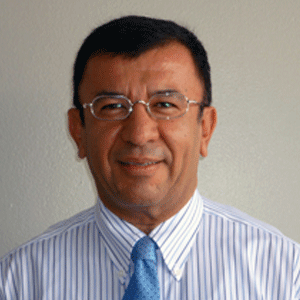Dr. Benjamin Bolaños
Contact Info
Education
- B.S. Biology , Universidad del Valle
- M.S. Medical Microbiology, Universidad de Antioquia
- Ph. D. Microbiology/ Immunology, Duke University
ACADEMIC PROFILES
RESEARCH INTEREST
In addition to genetic factors the environment could be important to explain the high prevalence of asthma in Puerto Rico. Our laboratory is interested in the environmental factors that trigger asthma in the Island. After certification by the National Allergy Bureau of the American Academy of Allergy Asthma and Immunology (aaaai.org/nab) we have been reporting the daily concentration of pollen and fungal spores for the past 5 years. This is the only accredited facility working in the tropics and therefore could be pioneer in this type of studies for other tropical areas of the world. We have observed correlation between the high levels of fungal spores (red alert levels >139,000 spores/m3 and an increase in the utilization of medical services (emergency room visits and hospitalizations) due to asthma. The season of allergic rhinitis and asthma is during the rainy months of September through November. On this season the high dew point, relative humidity, and rain promote the liberation of the fungal spores.
Diagnosis of allergic conditions due to fungi
The most common outdoor aeroallergen in Puerto Rico are the fungal spores. In addition to the very high levels of fungal spores is important to mention that over 90% of the outdoor fungal spores are Basidiomycetes (60%) and Ascomycetes (30%). No commercial extracts for these fungi are available. It is therefore very likely that the sensitivity to fungi detected by commercial extracts is underreported. There is a need of new diagnostic methods to basidiospores and ascospore allergens in Puerto Rico and other tropical regions. By the use of the Haloantigen assay we were able to demonstrate the sensitivity of patients to the outdoor fungal spores. Reactivity of the IgE to the release of allergens in germinated spores had help detect the allergic response to the outdoor aeroallergens
Purification of Ganoderma applanatum extracts of for the diagnosis of allergies.
The Ganoderma applanatum produces trillion of spores every day and therefore is a basidiomycete that is always detected in the air of San Juan. The skin test reactivity to crude extracts of G. applanatum was similar to the sensitivity to mites in a group of 33 patients with asthma and allergic rhinitis. This reactivity was significantly higher than of commercially available fungi. We will be purifying the crude extract of G. applanatum by isoelectric focusing and test the purified fractions for IgE reactivity using Western blots.
This assay will be tested as new immunodiagnostic tool for detection of allergies in PR and eventually in the immunotherapy of the patients sensitized to G. applanatum.
PUBLICATIONS
- Rivera Mariani FE, Nazario Jimenez S, Lopez Malpica F and Bolaños Rosero B. 2011. Sensitization to ascospores, basidiomicetes and fungal fragments by allergic rhinitis and asthmatic subjects in San Juan, Puerto Rico. Int. Arch of Allergy and Immunology
- E. Quintero, F. Rivera Mariani and B, Bolaños Rosero 2010. Analysis of environmental factors and their effects on fungal spores in the atmosphere of a tropical urban area (San Juan, Puerto Rico) Aerobiologia 23: 113-124
- Luberto,C. B. Martinez-Marino, D. Tarskeiwicz, B. Bolanos, P.Chtano, D. Toffaleti, G.M.Cox, J.R. Perfect, Y.A. Hannun, E. Balish and M. Del Poeta 2003. Identification of App1 as a regulator of Phagocytosis and Virulence of Cryptococcus neoformans. J. Clin. Invest. 112 (7): 1080-1094.
- Bolaños, B. and T.G. Mitchell. 1989. Phagocytosis of Cryptococcus neoformans by Rat Alveolar Macrophages. J. Med. Vet. Mycol. 27: 203-217
- Bolaños, B. and T.G. Mitchell 1989. Killing of Cryptococcus neoformans by Rat Alveolar Macrophages. J. Med. Vet. Mycol. 27:219-228
- Bolaños, B. and T.G. Mitchell 1989. Phagocytosis and Killing of Cryptococcus neoformans by Rat Alveolar Macrophages in the absence of serum. J. Leukocyte Biol. 46: 1-8

